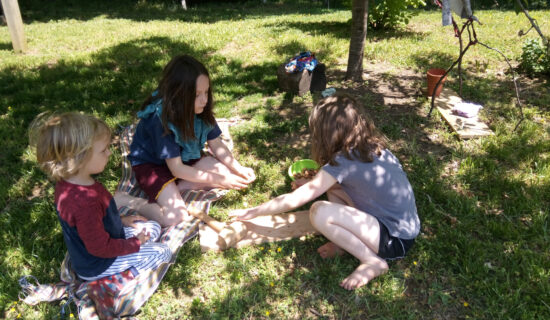Project-based learning is excellent fun and an effective way to learn most anything. Being able to read well opens more project opportunities and makes projects easier and more fulfilling. You don’t need a course or program to teach children to read. In the right environment, they will get it on their own! Part of the ‘right environment’ is frequent read-aloud. All learning is stronger when it is social—reading together is social.

The easy joy of reading aloud
Read-aloud isn’t just for bedtime! Whenever something isn’t going quite right, I revert to books on the couch. Perhaps there are siblings fighting, someone’s clingy, there’s general complaining, someone’s feeling low, or things Just. Keep. Happening. Time for time out.
Time out together on the couch reading always presses reset on our mood, energy, and attention. It’s worked for 18-month-olds and preteens. Select a book, maybe cuddle, start reading. If it’s not the right book, pick again.
There are benefits for family and home harmony, meeting individual needs for attention, and literacy development to boot!
Reading aloud is the best way to help pre-readers develop into readers.
Research shows that storybooks read by a caring parent or caregiver have a huge impact on a child’s academic and emotional development (Morrow, 1983; Santos and Shaffer, 2012). Of all the factors said to influence early literacy, shared book-reading is the most critical (Newman, 1999).
When we read aloud, babies and young children learn about the way we make meaning out of text, how the written word differs from the spoken word, the structure of stories, and eventually how to decode language.
Reading aloud boosts big kids skills, too.
Bigger kids get a boost in fluency for their own reading. They are exposed to new words, ideas, and facts about the world—background knowledge—that makes all of reading and learning easier. You can read material that is age-appropriate but too textually complicated so that they can have the exposure to stories and information that would be too hard to read on their own. Plus, read-aloud is often what kids remember most.
I remember my dad reading Tom Sawyer aloud to us as kids and my 4th grade teacher reading Roald Dahl’s The BFG. What do you want to share with your kids?
5 Rules for Read-aloud:
- Read anytime, for anyone. Don’t reserve books for little kids or bedtime only. If you have time—or need time!—try reading together. Though it builds skills much faster in young children, there is no stage at which reading aloud ceases to be beneficial or pleasurable. (Note the success of audio books for adults!)
2. Don’t be afraid to quit a book! If it doesn’t keep their interest after a few pages (little kids) or a few chapters (big kids), it’s got to go! There are many reasons to quit a book and there’s no shame in doing so. We recently started one that was very good but just too sad. Everyone agreed that, though we wanted to know what happened, it was getting us down.
3. Only read as long as you all want to. Maybe one chapter more—or one more picture book—if they beg you and you can make it work. (Stop before you must so that there’s room for an encore if it’s called for.) When the kids are done listening, you’re done. This is supposed to be pleasant.
4. Try all kinds of books. First of all, no one is ever too old for a good picture book. Don’t neglect non-fiction books or the types of stories you wouldn’t normally pick. I really like using books with no words for kids under about 10. They can tell the story, make inferences, and use creativity to fit language to images—all great literacy skills!
5. Talk about what you read! Sometimes adults think that children should be quiet and listen to the whole story before making a comment, but if you’re trying to grow a reader, this is the opposite of the truth! (Storytime librarians are often culprits.) Where there is no interaction, no discussion, questioning, or connecting, the deeper benefits of reading aloud are lost (Morrow, 2009).


